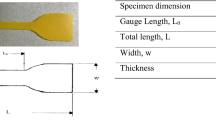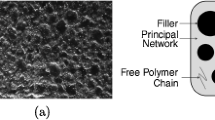Abstract
In the present paper, a viscoelastic elastomer is investigated with respect to the influence of moisture on its mechanical behavior. Uniaxial relaxation tests are executed at room temperature with different levels of moisture content. The model consists of a finite viscoelastic and incompressible approach wherein the mechanical parameters are coupled to the moisture content. For numerical investigations, all necessary balance and constitutive equations are implemented in the open-source C++ finite element code deal.II (Bangerth et al. in ACM Trans Math Softw 33(4):24/1–24/27 2007). With the help of this implementation and by comparing experimental results for dry, intermediate and fully saturated specimens and the results gained from simulations, the precise material parameters of the used polymer can be identified.
Similar content being viewed by others
References
Amin A., Lion A., Sekita S., Okui Y.: Nonlinear dependence of viscosity in modeling the rate-dependent response of natural and high damping rubbers in compression and shear: Experimental identification and numerical verification. Int. J. Plast. 22(9), 1610–1657 (2006)
Amin A., Lion A., Höfer P.: Effect of temperature history on the mechanical behaviour of a filler-reinforced nr/br blend: Literature review and critical experiments. Z. Angew. Math. Mech. 90(5), 347–369 (2010)
Babuska I.: The finite element method for elliptic equations with discontinuous coefficients. Computing 5(3), 207–213 (1970)
Bangerth W., Hartmann R., Kanschat G.: deal II – a general purpose object oriented finite element library. ACM Trans. Math. Softw. 33(4), 24/1–24/27 (2007)
Betten J.: Finite Elemente für Ingenieure 2: Variationsrechnung, Energiemethoden, Näherungsverfahren, Nichtlinearitäten, Numerische Integrationen. Springer, Berlin (1998)
Björck A.: Numerical Methods for Least Squares Problems. Society for Industrial and Applied Mathematics, Philadelphia (1996)
Braess D.: Finite Elemente: Theorie, schnelle Löser und Anwendungen in der Elastizitätstheorie. Springer, Berlin (1997)
Brezzi F.: On the existence, uniqueness and approximation of saddle-point problems arising from lagrangian multipliers. Rev. Fr. Autom. Inf. Rech. Oper. 8, 129–151 (1974)
Coleman B., Gurtin M.: Thermodynamics with internal state variables. J. Chem. Phys. 47(2), 597–613 (1967)
Coleman B., Noll W.: The thermodynamics of elastic materials with heat conduction and viscosity. Arch. Ration. Mech. Anal. 13(1), 167–178 (1963)
Cormen T., Leiserson C., Rivest R., Stein C.: Introduction to Algorithms. MIT Press, Cambridge (2001)
Crank J., Nicolson P.: A practical method for numerical evaluation of solutions of partial differential equations of the heat-conduction type. Adv. Comput. Math. 6(1), 207–226 (1996)
Engelhard M., Lion A.: Modelling the hydrothermomechanical properties of polymers close to glass transition. Z. Angew. Math. Mech. 93(2-3), 102–112 (2013)
Greiner R., Schwarzl F.: Volume relaxation and physical aging of amorphous polymers I. theory of volume relaxation after single temperature jumps. Colloid. Polym. Sci. 267(1), 39–47 (1989)
Haupt P.: Continuum Mechanics and Theory of Materials. Springer, Berlin (2002)
Haupt P., Lion A.: On finite linear viscoelasticity of incompressible isotropic materials. Acta Mech. 159(1-4), 87–124 (2002)
Haupt P., Lion A., Backhaus E.: On the dynamic behaviour of polymers under finite strains: Constitutive modelling and identification of parameters. Int. J. Solids Struct. 37(26), 3633–3646 (2000)
Johlitz M.: Experimentelle Untersuchung und theoretische Modellierung von Maßstabseffekten in Klebungen. Shaker Verlag, Herzogenrath (2008)
Johlitz M., Scharding D., Diebels S., Retka J., Lion A.: Modelling of thermo-viscoelastic material behaviour of polyurethane close to the glass transition temperature. Z. Angew. Math. Mech. 90(5), 387–398 (2010)
Johlitz, M., Retka, J., Lion, A.: Chemical ageing of elastomers: Experiments and modelling. ECCMR 2012 pp 113–118 (2012)
Koprowski-Theiß N., Johlitz M., Diebels S.: Modelling of a cellular rubber with nonlinear viscosity functions. Exp. Mech. 51(5), 749–765 (2011)
Ladyzhenskaya O.A.: The mathematical theory of viscous incompressible flow. Gordon and Breach, New York (1969)
Lion A., Johlitz M.: On the representation of chemical ageing of rubber in continuum mechanics. Int. J. Solids Struct. 49(10), 1227–1240 (2012)
Lion A., Peters J., Kolmeder S.: Simulation of temperature history-dependent phenomena of glass-forming materials based on thermodynamics with internal state variables. Thermochim. Acta 522(1-2), 182–193 (2011)
Reese S., Govindjee S.: A theory of finite viscoelasticity and numerical aspects. Int. J. Solids Struct. 35(26-27), 3455–3480 (1998)
Schäfer S.: Numerik im Maschinenbau. Springer, Berlin (1999)
Schwarz, H.R.: Methode der finiten Elemente. Teubner Studienbücher, Stuttgart (1980)
Steinbuch R.: Finite Elemente - Ein Einstieg. Springer, Berlin (1998)
Taylor C., Hood P.: A numerical solution of the Navier-Stokes equations using the finite element technique. Comput. Fluids 1(1), 73–100 (1973)
Tobolsky A.V.: Mechanische Eigenschaften und Struktur von Polymeren. Berliner Union, Stuttgart (1967)
Tortora M., Gorrasi G., Vittoria V., Galli G., Ritrovati S., Chiellini E.: Structural characterization and transport properties of organically modified montmorillonite/polyurethane nanocomposites. Polymer 43(23), 6147–6157 (2002)
Yeoh O.: Some forms of the strain energy function for rubber. Rubber Chem. Technol. 66(5), 754–771 (1993)
Yeoh O., Fleming P.: A new attempt to reconcile the statistical and phenomenological theories of rubber elasticity. J. Polym. Sci. Part B Polym. Phys. 35(12), 1919–1931 (1997)
Author information
Authors and Affiliations
Corresponding author
Rights and permissions
About this article
Cite this article
Goldschmidt, F., Diebels, S. Modelling and numerical investigations of the mechanical behavior of polyurethane under the influence of moisture. Arch Appl Mech 85, 1035–1042 (2015). https://doi.org/10.1007/s00419-014-0943-x
Received:
Accepted:
Published:
Issue Date:
DOI: https://doi.org/10.1007/s00419-014-0943-x




